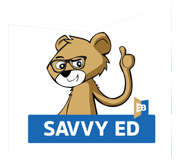What is Savvy Ed like?
Savvy Ed is very ambitious. Children aged 7-10, who are actually still very young, master a vast amount of course material. At the same time, Savvy Ed is exceptionally learner-friendly; the secret to our success lies in the fact that our students do not realise how much they learn and how much we expect of them. They learn so easily because we build on their knowledge and language experience acquired in the past years.
Key concepts of the Savvy Ed method:

SNOWBALL EFFECT
or gradual progress through repetition, sentence use and proper organisation of language content

COMPACT AND ALL-ENCOMPASSING DESIGN
Much more than just a coursebook, Savvy Ed is a comprehensive teaching philosophy, incorporating both a well-designed course content and a complete set of teaching aids. While developing the course, we considered the point of view of all parties involved, including students, parents, teachers and school managers.

MOTIVATION SCHEMES
As they have been integrated in the method itself, they cannot be left out! Elements of GAMIFICATION are used in class (e.g. children collect gold nuggets to build their own Gold Kingdom). Savvy Ed sends letters to students from his travels around the world to motivate them and reward their active participation and involvement.

FORMATIVE ASSESSMENT
To support the development and to unlock the full potential of our young students, evaluation of learning outcomes is based on the FORMATIVE ASSESSMENT method.
About the course:
Each Savvy Ed level has been designed for 60 class meetings in a language school environment, lasting 60 minutes each. The course may also be taught at private elementary schools, where five 45 minute classes a week are required.
TEACHERS who conduct classes undergo a strict recruitment process according to the Licenser’s guidelines. The aim of this process is to evaluate their overall level of language competence, English pronunciation and their ability to work with children.
Those selected are offered training in the specifics of working with elementary school children and our language teaching method. We also equip them with detailed instructions, procedures, lesson plans and supplementary materials to enrich their lessons.
Classes are regularly supervised and discussed with a Local Savvy Ed Method Coordinator. Selected lessons are recorded and analysed by the Licenser’s methodology consultants. They are evaluated against our SAVVY ED METHOD STANDARD, not only to maintain the highest quality of courses, but also to constantly offer new development opportunities for teachers.
One very important aspect of the method is ONGOING TEACHER-PARENTS COMMUNICATION. Parents can expect:
- verbal reports about course material covered in class and homework assigned, provided after each session
- homework and course progress information provided in the Parent’s Book
- regular reports about course content covered, group progress and individual learners’ achievements provided in an electronic grade book or sent via email (depending on the school’s communication system)
- one open class per semester
Education Pack
Course components include:
Snowball Book a workbook
Recordings with stories, audio dramas, rhymes, songs and exercises
Parents Book a teacher-parent communication notebook where students can
stick notes or messages received from the teacher or the teacher can write
reports about the child’s progress and achievements.
A case
clear learning goals to be established and communicated both with regard to individual classes and the course as a whole. The aim is to build students’ awareness as to where they are headed and what end results are expected of them.
feedback at each stage of the learning process and ongoing teacher-parent communication. Teachers will provide feedback in class, as well as through reports or progress charts, informing students and parents what has already been mastered and what they should focus on
self-assessment skills development to help learners identify which areas they feel confident in and which require consolidation/ repetition
clear and transparent assessment criteria which are always communicated well IN ADVANCE of any exam, test or homework assignment so that students know exactly what is expected of them (success criteria)
Apart from formative assessment strategies, our Savvy Ed method also uses summative assessment, which involves measurement of students’ performance and outcomes against a given standard (usually a grading system). It is always success-oriented. Our key principle is: WE DO NOT GIVE GRADES OTHER THAN “A”! Basically, when children master a specific part of the course material, they receive an A. Each student is given a progress chart with detailed guidelines concerning skills required for specific tests or exams.
Savvy Ed at home and homework assignments
Savvy Ed is a method intended for young elementary school learners, which means that children still need their parents’ assistance when preparing for classes and completing their homework assignments. We are aware that it would be hard to expect a high level of learner autonomy at such early age. That is why teacher-parent communication and cooperation is of utmost importance both in terms of organisation, the didactic process and (perhaps most of all) motivation, which explains why we attach great significance to the quality of parent-teacher interactions.
Homework constitutes a strategic element of the whole program. The idea is not for parents to hold additional language classes at home or to substitute for the teacher, but to maximise language exposure. Classes are usually held only twice a week, which already puts a considerable burden on both parents and children (a busy afternoon, transport, etc.). However, by adding two 15-minute home assignments we are able to ensure more regular language exposure in the form of four sessions a week, which helps achieve tangible results. Our homework assignments have been carefully designed so that they are highly effective but require minimum time and effort on the part of our students and their parents.
